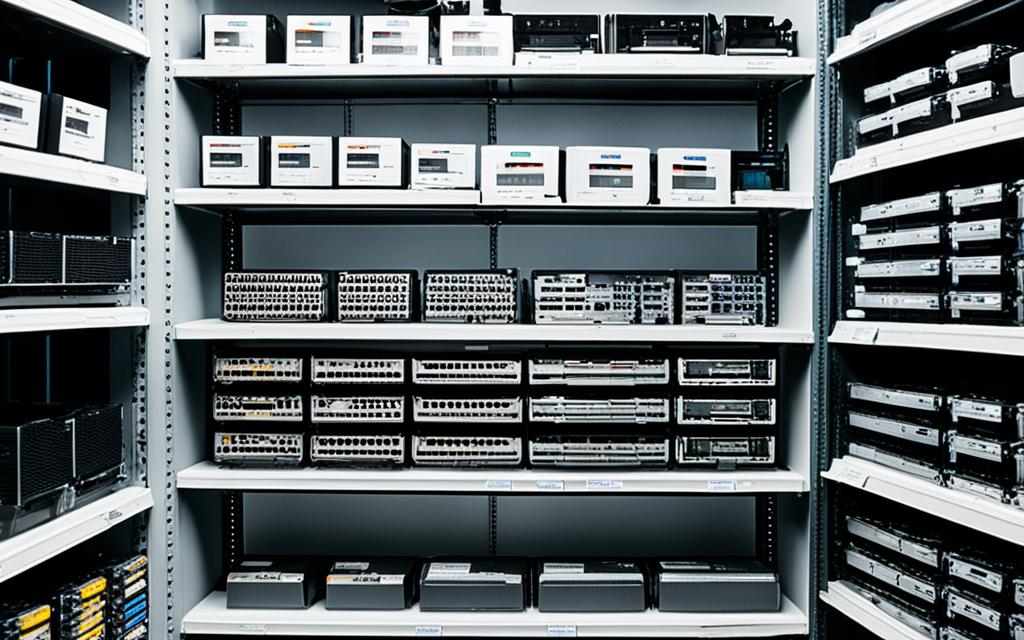Table of Contents
In today’s tech-driven world, a neat system for keeping computer parts is key for everyone. Good storage not only makes spaces tidier but also boosts work by cutting down the time to find parts. Offices often have over 30 hard drives, showing the big need for tidy computer parts1.
Inventive storage ways help maintain a tech area that’s great for work and upkeep. This makes getting to important tools quicker.
Tackling storage with stackable bins and clear labels can hugely improve part management. These steps, when put into practice, make a day’s work much smoother.
Key Takeaways
- Proper organisation can maximise efficiency in computer parts storage.
- Utilising stackable bins is a cost-effective method for management.
- Labeling components aids in easy access and maintenance.
- Regular checks can prevent damage and prolong the lifespan of parts.
- Incorporating anti-static storage options is essential for sensitive devices.
Understanding the Importance of Organised Computer Parts Storage
Keeping computer parts well-organised is key to a smooth workflow. A messy setup can really slow things down, especially where speed matters. Parts scattered around mean wasted time and stress finding what you need. Efficient storage ways can stop these issues, making work flow better2.
The Impact of Disorganisation on Workflow
Disorganisation can lead to big hold-ups. It’s tough when staff can’t find the parts they need quickly, and projects get stuck. This mess can drive up the cost of work and delay projects. In 2020, there was a huge blast of data, reaching 64.2 zettabytes, showing just how much there is to keep track of2.
Benefits of Efficient Storage Solutions
Good storage solutions bring many benefits. Using clearly labelled bins or shelves helps find things faster and reduces mistakes. This smoothens the process of getting what you need, boosting productivity. Organisations can also sort their data better with a good storage system3.
Adopting organised storage boosts work efficiency and creates a high-performing team culture. As tech keeps advancing, staying organised is crucial for handling loads of data and keeping operations smooth.
| Storage Method | Efficiency Rating (%) | Common Use Cases |
|---|---|---|
| Labelled Bins | 90 | IT departments, repair shops |
| Static Shelving | 80 | Office storage, parts storage |
| Vertical Lift Modules | 85 | Manufacturing, warehouses |
By updating their storage, businesses can make the most of their resources. This leads to better performance and success.
Best Practices for Storing Computer Components Safely
Storing computer components well is key for them to last long and work right. By using safe storage steps, you make sure the delicate hardware stays in good shape. Following the right handling methods can lessen the chance of harm when storing and moving them.
Ensuring Longevity through Proper Handling
Handling computer parts with care is essential to keep them working. Using anti-static bags and boxes prevents static damage. It’s crucial to ground yourself and your work area before touching any parts. Keeping a tidy, dry place is also important to avoid risks. Messy and dusty areas can raise the chance of static harm4.
It’s vital to touch components as little as possible to keep them working well. Don’t slide or shake parts, as this can make static electricity that hurts them. It is recommended to use ESD-safe tools when dealing with sensitive pieces4.
The Role of ESD Protection in Storage
Keeping parts safe from Electrostatic Discharge (ESD) when stored is very important. Wearing anti-static wrist bands while handling parts lowers static risk. It’s good to check your stored parts often to spot any harm early. Having a special spot for parts and using clear, marked bins helps keep things organised5.
Components should stay in a cool, dry spot away from sunshine. This maintains their quality and stops moisture problems, like short circuits. Steer clear of places where the temperature changes a lot to help your gear last longer5.
Innovative Storage Solutions for Optimal Management
When organising computer parts, the type of storage solution you choose matters a lot. It influences how efficient and accessible your storage is. Two noteworthy options are Vertical Lift Modules and different shelving systems. Each has unique pros and cons.
Vertical Lift Modules: Pros and Cons
Vertical Lift Modules, or VLMs, offer a space-efficient way to store a lot. They keep various components secure in a small area, improving workflow. However, they’re more expensive at first. It’s crucial for businesses to think about whether the cost is worth it.
Static Shelving vs. Mobile Shelving
It’s important to compare static and mobile shelving for their benefits. Static shelving is cheaper and easier to install, good for many needs. Mobile shelving, however, uses space better by reducing aisle size. Knowing the strengths of each shelving system helps in making smart storage choices.
| Storage Type | Advantages | Disadvantages |
|---|---|---|
| Vertical Lift Modules | High-density storage, enhanced workflow efficiency | Higher initial cost, requires evaluation of ROI |
| Static Shelving | Cost-effective, easy to set up | Limited space efficiency compared to mobile options |
| Mobile Shelving | Increased storage density, compact design | Potentially more complex installation and maintenance |
Choosing the Right Storage Containers for Computer Parts
It’s essential to choose the right storage containers for keeping computer parts organised. Stackable bins are great because they use vertical space well. This allows you to sort parts efficiently. These bins vary in size and material to meet different needs.
Advantages of Stackable Storage Bins
Stackable bins are very useful for several reasons:
- They make the most of vertical space, giving you more room.
- They help keep things organised with different sizes and sections.
- You can quickly get to the parts you need, saving time.
These bins are practical and come at various prices. For example, a 64-drawer cabinet from Akro-Mils costs between $44.36 and $49.996. A smaller, 12-drawer cabinet by Tactix is priced at $35.906. These prices show the range of options for specific needs.
Labelling and Documenting for Easy Access
Proper labelling is key to finding things easily. A good label system helps you see what’s inside each bin at a glance. Labels should clearly indicate the contents, making things faster to find when needed. The right label makes a big difference in staying organised.
Being organised boosts productivity. Many people use databases or spreadsheets to keep track of their parts. About 40 containers are often used just for development tools and parts7. Digital tracking prevents buying the same thing twice, saving money and time.
Computer Parts Storage: Creating an Effective System
To make a storage system work, you need to think carefully about different methods. A tidy workspace boosts productivity. It’s key to match various storage types, like shelving for big parts with bins for little ones.
Combining Various Storage Methods
An effective storage blends methods for easy access and secure keeping of parts. Anti-static bags protect sensitive electronics from static damage8. Climate-controlled units keep spares in top shape8. Wrapping items in bubble wrap and foam keeps them safe8.
It’s crucial to regularly check and maintain your storage. Assessing tools such as drawer cabinets helps in storing delicate parts. Dividers in bins can boost tidiness. This way, every part has a place, ensuring a smooth workflow.
| Storage Solution | Advantages | Best For |
|---|---|---|
| Static Shelving | Easy access, durable | Heavier components |
| Stackable Bins | Space-saving, versatile | Small parts like screws |
| Drawer Cabinets | Secure, organised | Sensitive items like RAM |
| Anti-static Bags | Protects against ESD | Electronics |
Keeping organised means thinking ahead about the lifespan and repairs of parts9. Knowing the latest in part handling keeps your system useful for longer10. Being systematic turns storage into a key part of your workspace, bringing order and efficiency.
Conclusion
Efficient storage solutions for computer parts boost productivity and keep the parts safe. Organised storage systems help avoid risks like moisture and dust. This means valuable items are protected, and tech resources are managed well. It’s vital to keep to the right temperature of 10°C to 27°C and humidity levels of 30% to 50%. This care extends the life of delicate items like CPUs and graphics cards11.
Choosing smart storage and proper packaging shields hardware from static damage and transport harm. Regular checks and tests make sure stored hardware stays in working order11. The tech world is always changing. So, it’s important to keep updating how we store things to meet new needs. This helps keep operations smooth and effective.
Using advanced storage solutions and sharing knowledge in the industry helps businesses work better. This also prepares them for the future of tech workspaces. You can learn more about improving data management and storage from Google Drive for Desktop. It shows how cloud storage helps keep workflows organised and supports working together in real-time12.
FAQ
What are the benefits of implementing efficient storage solutions for computer parts?
Efficient storage solutions boost productivity by making it easier to find parts. With everything organised, work flows better. This makes the workplace more productive.
How does disorganisation impact IT departments and repair shops?
Disorganisation causes lost time and stress, especially where quick results are needed. If parts are scattered, it leads to delays and mistakes. This makes things less efficient.
What best practices should I adopt for handling sensitive computer components?
Always use anti-static bags and gloves for sensitive parts like RAM and CPUs. Also, anti-static wrist straps and mats are key to avoid Electrostatic Discharge (ESD). ESD can damage the components.
What are Vertical Lift Modules and how do they compare to shelving systems?
Vertical Lift Modules (VLMs) store many sized components in less space, making workflow better. But, they’re pricier than static or mobile shelving systems. Shelving systems are more affordable for general storage.
Why are stackable storage bins advantageous for storing computer parts?
Stackable bins use vertical space well and help sort components. They are versatile due to their different sizes and materials. This helps keep the workspace organised.
How can I create an effective storage system for my computer parts?
For an effective system, mix storage methods like shelving for big items and bins for small ones. Regularly checking what you have keeps your system organised. It also ensures it meets your changing needs.
Source Links
- https://community.spiceworks.com/t/how-do-you-organize-your-spare-computer-parts/308403 – How do you organize your spare computer parts?
- https://www.techtarget.com/searchstorage/definition/storage – What is computer storage and how is it used?
- https://typeset.io/questions/why-computer-parts-are-important-347ucylbqe – Why computer parts are important? | 5 Answers from Research papers
- https://www.linkedin.com/advice/0/what-best-practices-storing-transporting-pc-components – What are the best practices for storing and transporting PC components to prevent static damage?
- https://community.spiceworks.com/t/advice-on-managing-computer-hardware-storage-configuring-room/330365 – Advice on managing computer hardware storage/configuring room
- https://makeradvisor.com/best-storage-organizers-for-electronic-components-and-parts/ – Best Storage Organizers For Electronic Components and Parts – Maker Advisor
- https://community.element14.com/members-area/f/forum/39846/lets-talk-storage – Lets Talk Storage
- https://www.xtraspace.co.za/blog/articles/how-to-store-computer-parts/ – How to Store Computer Parts – Xtraspace | Self Storage | Business Storage
- https://scot-comp.co.uk/how-to-safely-handle-and-store-computer-components/ – How to Safely Handle and Store Computer Components –
- https://www.crucial.com/articles/pc-builders/how-to-build-a-computer – How To Build Your Own PC | Parts, Budget, Step-by-Step
- https://softwareg.com.au/blogs/computer-hardware/how-to-store-computer-hardware – How To Store Computer Hardware
- https://nap.nationalacademies.org/read/4829/chapter/7 – 5 Conclusions and Recommendations | Computer-Aided Materials Selection During Structural Design








